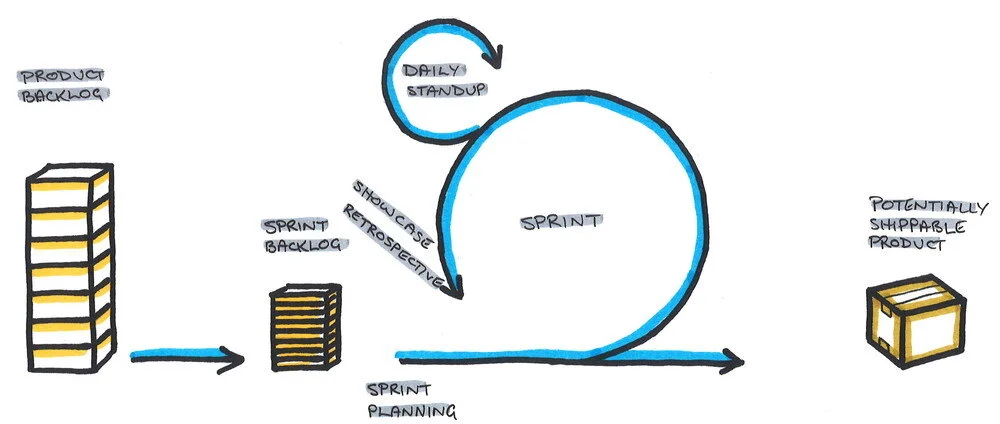Agile - The Why, The How, The Who
Background: The text below has been initially written by Sarah to provide a group of Government Executives with a snapshot overview of what Agile is. We found it too valuable not to share with a wider audience.
Why - The Benefits of Agile
“Agile” is a collection of practices and behaviours, assisting teams to build products iteratively, delivering early and often. Agile allows us to design services that help people be more accurate, compliant and efficient in their interactions with government.
Agile accelerates value, and therefore accelerates benefits realisation
an iterative approach, enabling teams to break traditional business cases down into digestible, prioritised and deliverable pieces of work
a mechanism to satisfy the business and customer through early and continuous delivery of valuable software
Agile minimises waste and risk
a mechanism for providing rapid, regular business and customer feedback
an iterative approach, allowing teams to inspect and adapt throughout delivery, ultimately decreasing delivery risk
supports changing requirements for the businesses competitive advantage
“The implementation of Agile techniques and practices needs to be contextual to the environment and constraints.”
Agile is a proven best in practice approach for software development, having been implemented globally within both private and public sectors. Agile has been adopted to enable leading digital initiatives within complex and regulated environments, such as finance and government.
How - The Flavours of Agile
There are many interpretations of “Agile”, varying processes and methodologies, such as Scrum or Kanban. However, the implementation of Agile techniques and practices needs to be contextual to the environment and constraints. A purist implementation will be at the detriment of the organisation. As such, teams are encouraged to consider Agile a toolkit and apply relative to the problem they are looking to solve.
How - The Agile Operating Model
Unlike traditional methodologies such as Waterfall, Agile leverages an incremental approach to delivery. Teams work iteratively through a prioritised backlog, providing opportunity for regular feedback on customer needs. Teams are able to inspect and adapt, closing the feedback loop, decrease risk and ultimately improve quality and efficiencies.
The operating model fostered within an Agile environment enables discipline and rigour on planning, forecasting and stakeholder management. Teams work on a regular cadence, also known as Sprints; a time-boxed rhythm typically of 2 weeks. During the Sprint the team conducts a number of working sessions to plan their work, forecast and track, showcase progress and raise impediments affecting their productivity.
By the very nature of large organisations it is rare that teams exist within a purely Agile environment. There are situations where Agile teams need to integrate into legacy teams and processes. The Agile operating model is well suited for such integration, e.g. project management requirements of a PMO.
Who - The Team and Culture
“The team and culture are at the core of an Agile organisation”
“Being” Agile is as critical as “doing” Agile. Therefore, the team and culture are at the core of an Agile organisation. The benefits of Agile are maximised when teams are formed around the following guiding principles:
Cross-functional, multi disciplinary, self sufficient - breaking down traditional silos, Agile teams contain the required skill sets to complete the work within the team, minimising dependencies outside of the team and costly handoffs.
Small, collocated - verbal communication is the primary vehicle for teams, therefore they are typically ~10 people collocated, ensuring collaboration is tight and focussed.
Empowered - decision-making is decentralised to the lowest level possible, ideally to the team itself, minimising coordination and wait time. Typically Product Ownership is present within the teams, ensuring they are in a position to prioritise and progress without reaching outside.
Long standing, stable - the dynamics and relationships formed within a team are critical, increasing collaboration and therefore efficiencies. Unlike traditional teams - which disband at the completion of a project- Agile teams remain as a unit, iterating on the product, while working to the guiding principle of “move the work, not the people” in scenarios of work allocation.
Learning culture, experimentation - continuous improvement is a key ingredient for Agile teams, both assessing the product and the process. As such, Agile teams are typically inquisitive, regularly inspecting and adapting, seeking learnings to apply as their progress. Within the Agile operating rhythm, ceremonies are in place to ensure teams are discovering the truth early, “fail fast, fail small”, ultimately reducing risk and delivering the optimal product.






